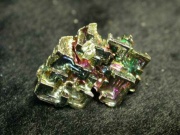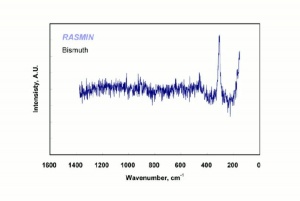Difference between revisions of "Bismuth"
| Line 50: | Line 50: | ||
° Mineralogy Database: [http://www.webmineral.com/data/Bismuth.shtml Bismuth] | ° Mineralogy Database: [http://www.webmineral.com/data/Bismuth.shtml Bismuth] | ||
| − | == Authority == | + | == Authority (list of all sources checked for information on this subject)== |
* ''Chemical & Engineering News'', American Chemical Society, Washington DC, 81 (36) , Sept. 8, 2003 Comment: Nei Burford, p. 156 | * ''Chemical & Engineering News'', American Chemical Society, Washington DC, 81 (36) , Sept. 8, 2003 Comment: Nei Burford, p. 156 | ||
Revision as of 09:46, 30 October 2015
Description
A brittle metallic element occurs as a native element and as sulfur, oxide or carbonate minerals. Although bismuth was known as a metal as early of the 15th century, it was not isolated until 1737 by Hillot. Its concentration in the earth's crust is 0.2 ppm. Bismuth occurs in Saxony and Bolivia and is found in other areas often associated with Lead, Copper, Cobalt, Nickel and Tin ores. Bismuth is a grayish white lustrous metal that is oxidized by air. Since it is a poor conductor of electricity, bismuth is used in fuses where an electrical surge melts the metal and breaks the circuit. Currently bismuth salts are used in cosmetics and medicine. Metallic bismuth is added to alloys to improve machinability. It is also used in semiconductors and to make the pigment bismuth white. Bismuth is opaque to x-rays and is used in fluoroscopy. Historically, metallic bismuth was used as a dark gray decorative pigment and metallic paint ground on small boxes (Gold 1998). As a ground, powdered bismuth in a gum arabic binder was probably applied to chalk grounds then burnished to form a reflective surface. Powdered bismuth was also mixed with albumin or glue to form 'silver ink'. Bismuth alloys have low melting points and are often used in fire-detection devices.
Synonyms and Related Terms
Bi; silver ink; Bismut (Deut.); bismuto (Esp., It., Port.); bismut (Ned.); vismut (Nor., Sven.); bizmut (Pol.);
Other Properties
Attacked by dilute nitric acid, concentrated hydrochloric acid.
| Composition | Bi (atomic no. 83) |
|---|---|
| CAS | 7440-69-9 |
| Mohs Hardness | 2.25 |
| Melting Point | 271.3 |
| Density | 9.78 |
| Molecular Weight | atomic wt = 209.9804 |
| Boiling Point | 1420 |
Hazards and Safety
Powder is flammable. Contact and inhalation may cause mild irritation. Ingestion may cause black spots on gums. Bismuth salts are poorly absorbed.
Mallinckrodt Baker: MSDS
Additional Information
° R.Gold, "Reconstruction and Analysis of Bismuth Painting", in Painted Wood: History and Conservation, Getty Conservation Institute, Los Angeles, 1998.
° Mineralogy Database: Bismuth
Authority (list of all sources checked for information on this subject)
- Chemical & Engineering News, American Chemical Society, Washington DC, 81 (36) , Sept. 8, 2003 Comment: Nei Burford, p. 156
- Wikipedia, the free encyclopedia, at http://www.wikipedia.com
- Richard S. Lewis, Hawley's Condensed Chemical Dictionary, Van Nostrand Reinhold, New York, 10th ed., 1993
- Van Nostrand's Scientific Encyclopedia, Douglas M. Considine (ed.), Van Nostrand Reinhold, New York, 1976
- Random House, Webster's Encyclopedic Unabridged Dictionary of the English Language, Grammercy Book, New York, 1997
- The Merck Index, Martha Windholz (ed.), Merck Research Labs, Rahway NJ, 10th edition, 1983 Comment: entry 1297
- The American Heritage Dictionary or Encarta, via Microsoft Bookshelf 98, Microsoft Corp., 1998
- Encyclopedia Britannica, http://www.britannica.com Comment: bismuth" [Accessed December 11, 2001
- G.S.Brady, Materials Handbook, McGraw-Hill Book Co., New York, 1971 Comment: p. 104
- C.W.Chesterman, K.E.Lowe, Audubon Society Field Guide to North American Rocks and Minerals, Alfred A. Knopf, New York, 1979
- R.D. Harley, Artists' Pigments c. 1600-1835, Butterworth Scientific, London, 1982

